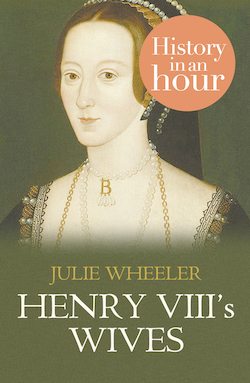Читать книгу Henry VIII’s Wives: History in an Hour - Julie Wheeler - Страница 7
ОглавлениеAnne Boleyn
Born: c. 1500. Died: 19 May 1536. Queen: 28 May 1533–17 May 1536.
In the 1520s no one could possibly have imagined how Anne was so cleverly to succeed where Henry’s previous extra-marital lovers had failed. Anne proved herself the ultimate career woman in a world where one of the few career choices for women was wedlock.
On her father’s side, Anne Boleyn’s lineage was made up of the merchant middle class. Her great-grandfather, Geoffrey Boleyn, was the family’s original entrepreneur. Trading success had made him mayor and he received a knighthood. He invested for his descendants by purchasing Blickling Hall in Norfolk and Hever Castle in Kent. The following Boleyn men married well, none more so than Geoffrey’s grandson, and Anne’s father, Thomas Boleyn. He married Elizabeth Howard, daughter of the second Duke of Norfolk, whose ancestry was peppered with dukes and earls.
This painting is inscribed with ‘Anna Bullen at Hever Castle’ and there is uncertainty on the date and artist
Anne’s parents married by 1500. They then had their three children in quick succession; Mary, Anne and George. There is no certainty for Anne’s date of birth, but she was born around 1500, certainly by 1503.
Thomas’ political talent enabled him to join the royal service where he excelled and earned continued promotion, becoming a servant of the body for Henry VIII and a knight of the Bath. Having worked on matters of state at the court of Margaret, Duchess of Savoy, in Brussels, Thomas was able to secure a position there for his daughter, Anne. This appointment saw Anne flourish and her father clearly recognized her emerging talents. She understood courtly politics and was rapidly learning French. In 1514 Anne was transferred to the court of France. Here, she was able to develop her burgeoning skills.
Anne loved the French language and soon became fluent. She learnt how to impress with music and poetry. French culture enabled her to become a clever conversationalist and release a ready wit. She also mastered the skill of overt flirtation without damaging her chaste reputation.
Anne Boleyn was a vivacious, cultured and fascinating young woman by the time she was recalled to England in 1521 to marry James Butler, both a cousin and heir to the Earl of Ormonde. There was some dispute as to whether Thomas Boleyn should inherit this earldom and so, in agreement with King Henry VIII, this marriage offered the solution. As lengthy negotiations regarding the wedding were carried out, Anne took a position in the English court as one of Queen Katherine’s maids. The first recorded appearance of Anne at the English court was Shrove Tuesday, 1 March 1522, in a masque in which she was cast as Perseverance.
Cardinal Thomas Wolsey (pictured below), as lord chancellor, had some say in court matters, including marriages, but despite his efforts, the marriage agreement between Anne and James did not reach fruition. It is believed that differences between Thomas Boleyn and Piers Butler, James’ father, had become irreconcilable.
Cardinal Thomas Wolsey, painted by Sampson Strong around 1526 at Christ Church
As far as finding another suitor was concerned Anne would have no problem. French-styled manners and accomplishments were fashionable within the English court during the 1520s, and Anne effortlessly became a celebrated member of Queen Katherine’s entourage. She was romantically linked to the poet Thomas Wyatt, who became besotted with her (although it is doubtful whether the interest was reciprocated except in the courtly way). Wyatt had already taken advantage of an arranged marriage and here, for the first time, Anne Boleyn clearly demonstrated that an aspirational marriage was her plan, not a sullied reputation as a mistress. She focused her ambitious energy upon another match.
Henry Percy was the wealthy son and heir to the Earl of Northumberland, also under the influence of Cardinal Wolsey. A loving romance blossomed between Anne and Percy and they entered into a secret betrothal. Unfortunately the couple were unaware that Percy’s father, the earl, had already negotiated a betrothal for his son to marry Mary Talbot, daughter of the equally wealthy Earl of Shrewsbury, and he fully intended his son to honour the contract. The cardinal called a halt on plans between Anne and Henry Percy. Besides, it was around the same time as James Butler was being proposed for Anne.
The question remains: did Cardinal Wolsey prevent the marriage of Anne and Percy to appease the Earl of Shrewsbury or because King Henry VIII had fallen for Anne himself by this time and had ordered him to so? Henry Percy was forced to marry Mary Talbot regardless of the heartbroken protests that he and Anne proffered. The vehemence of Anne’s protestations resulted in her being removed from court by her family during the summer of 1525. By autumn she was allowed to return. Whether Henry VIII was responsible for enforcing the separation of Percy from Anne or not, he was now able to pursue her unhindered.
Having set her sights on becoming a wife, Anne demonstrated to Henry that he could not control her head or heart. She expertly kept him dangling for more than a year, using all her courtly skills, giving nothing real away. During this time Henry inundated Anne with love letters full of promises, declarations and presents. The response he received often left him perplexed and, along with her refusal to sleep with him, inflamed his passion to a level he had not previously encountered. Bessie Blount and Mary Boleyn had been comparative walkovers.
